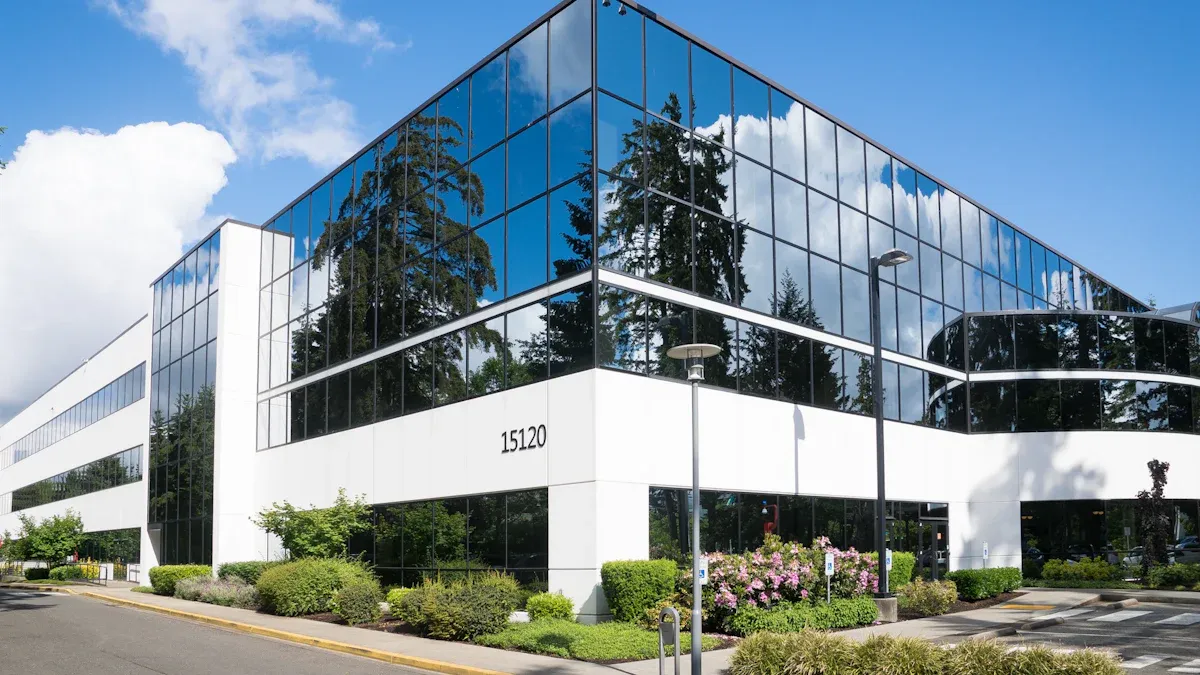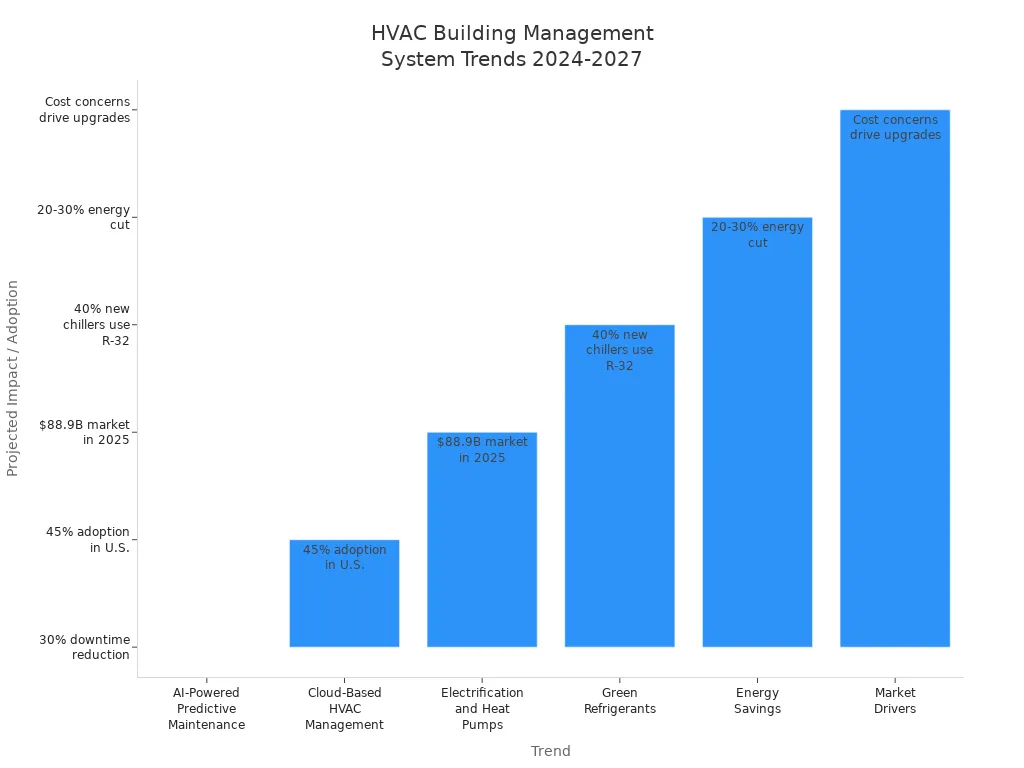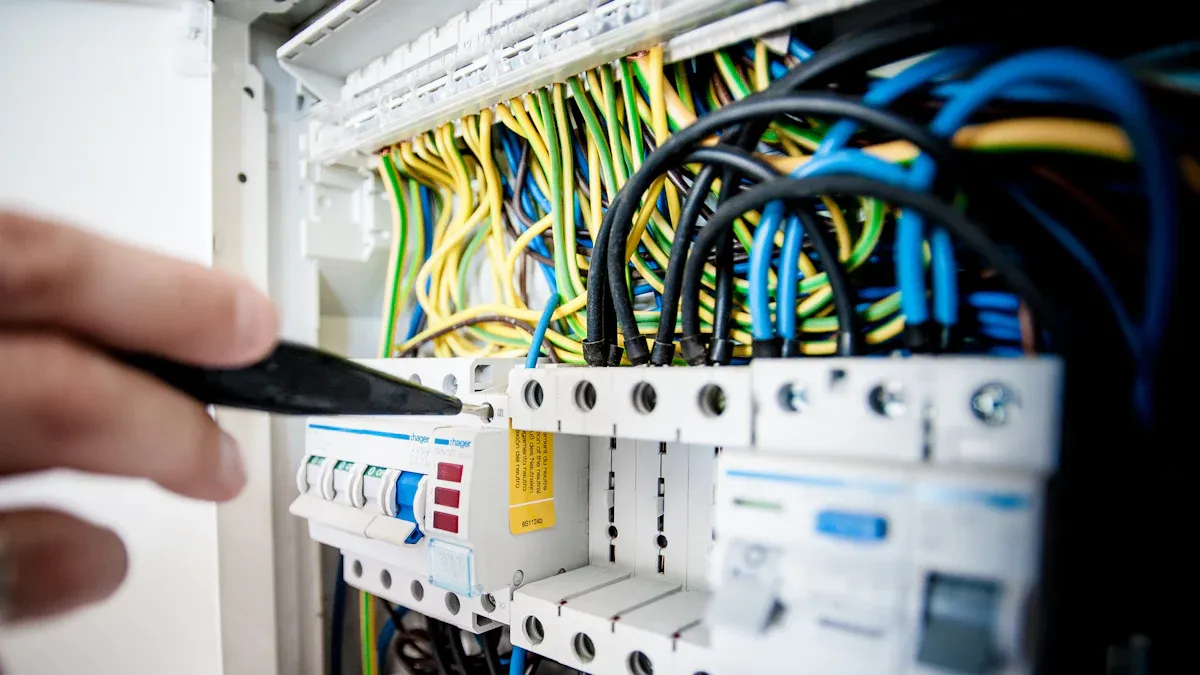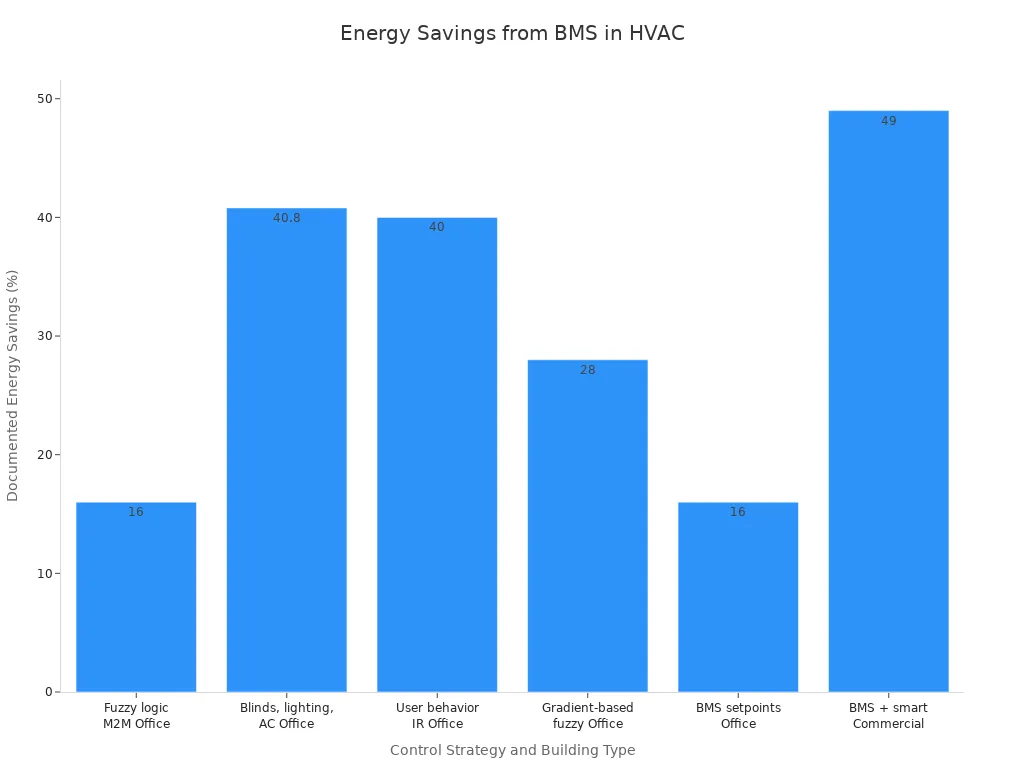
Understanding Building Management System(BMS) in HVAC is essential for modern facility management. A building management system is a computer-based control system that oversees and manages HVAC operations within a building. Understanding Building Management System(BMS) in HVAC allows facility teams to efficiently control heating, ventilation, and air conditioning, as well as other critical building systems, all from a central platform. Despite its benefits, only 13% of small and medium commercial buildings in the U.S. currently use a building management system for HVAC control, highlighting the need for wider adoption. Understanding Building Management System(BMS) in HVAC empowers teams to enhance comfort, safety, and energy efficiency. Research shows that smart control system strategies, when integrated into a building management system, can reduce energy consumption by up to 30% while maintaining occupant comfort. Leveraging advanced control system technology and IoT within Understanding Building Management System(BMS) in HVAC enables real-time adjustments and predictive maintenance.

Learning about Understanding Building Management System(BMS) in HVAC helps facility managers achieve better outcomes through automated control system solutions.
what is a bms system? what is bms system? A building management system (BMS) helps control heating, ventilation, and air conditioning (HVAC) from one main place. It saves energy and makes people more comfortable.
Smart BMS like iDste use sensors and automation to change settings right away. This makes buildings safer, more efficient, and easier to handle.
Using a BMS can cut energy use by up to 30%. It also lowers costs and helps HVAC equipment last longer by finding problems early and fixing them before they get worse.
Important parts of a BMS are sensors, controllers, user interfaces, and communication networks. These work together to keep buildings comfortable and save energy.
Remote monitoring lets facility managers check and control bms HVAC systems from anywhere. This helps them fix problems fast and keep buildings working well.
This smart system uses special tools to help managers watch and control HVAC systems easily. iDste is different because it has features that make a bms work better in real life.
iDste has a Networked Media Processor (NMP) that controls many devices, like air conditioning units. This processor lets people handle big HVAC systems from one spot.
The smart system uses IoT-driven automation. Sensors check temperature, humidity, and air quality. They make quick changes to keep rooms safe and comfortable.
Easy touch panels help staff run things every day. People can change settings fast and do not need extra training.
iDste works well in spaces used for many things. It controls devices in rooms next to each other. This helps schools, offices, and big buildings save time and energy.
The system lets teams watch and manage things right away. Facility teams can see data and fix problems early with cloud-based tools.
iDste technology makes campus work easier, keeps people safe, and saves resources. It is also more user-friendly than old building management systems.
Facility managers get real-time data and smart automation. The smart system finds problems early and sends alerts, so there is less downtime. The bms software in iDste helps with predictive maintenance. This saves money and helps equipment last longer. The hvac building management system HVAC also cuts down on wasted energy by making changes when sensors notice something.
A smart system like iDste gives teams more control over HVAC. It uses a strong control system to manage resources and keep people happy. Real-time data helps managers make fast choices. iDste shows how a new bms can change how buildings run HVAC and other systems.
A building management system bms is very important for HVAC today. Facility managers use a smart building management system to watch and control energy use. The bms connects hardware and software together. It can change settings based on how many people are in the building, the temperature, and how much energy is used. This means energy is only used when needed. This helps save money on bills and makes the building work better.
Facility teams use a building management system to follow rules from the city or country. The bms keeps track of HVAC data and checks it. This helps avoid fines and keeps everyone safe. Automated controls do simple jobs for staff. This lets workers focus on bigger tasks. A smart building management system can also find equipment problems early. Predictive maintenance helps machines last longer and cost less to fix. This makes the building work better.
A smart building management system keeps people comfortable inside. It controls temperature, humidity, and lighting. This makes the space nice to be in. The system collects good data and makes reports. This helps people make smart choices and follow energy rules. Real-time monitoring lets managers act fast when things change. This makes the hvac system work better and helps the whole building.
A building management system /building bms system helps air quality and saves energy. The table below shows how bms features help with indoor air and hvac efficiency:
Aspect | Contribution to Improved IAQ and HVAC Efficiency |
|---|---|
Centralized Control | Lets managers change heating, cooling, and ventilation right away using sensor data and how many people are there |
Smart Demand Controlled Ventilation (SDCV) | Changes air flow to match how many people are in the room and uses energy-saving air cleaning |
Energy Efficiency | Air cleaning uses much less energy than old HVAC systems, saving about 40% on energy costs |
Data-Driven Optimization | Uses smart guesses and sensor data to keep equipment working well and air clean |
Integration with Advanced Technologies | Uses real-time sensor data, checks if people are there, and uses air cleaning tools |
Sustainability | Helps lower pollution by saving energy and using green energy sources |
A building management system with IoT and automation helps save energy all the time. Variable Frequency Drives (VFDs) change how machines work to use less energy when possible. The building energy management system helps fix things before they break. This stops big problems and saves money. These tools help the planet and make buildings work better.
A smart building management system is needed for any place that wants to save energy, keep people happy, and stay safe. It gives real-time information, helps follow rules, and saves money for a long time.

A building management system needs many important parts to work. Each part helps the system run well and stay dependable.
Sensors are like the system’s eyes and ears. They check things like temperature, humidity, pressure, air quality, and if people are in the room. These tools send live data to the bms. This helps the system make good choices. New sensors are more exact and faster than old ones. The table below shows how sensor types are different:
Sensor Type | Traditional Sensors | Advanced Sensors |
|---|---|---|
Temperature | Basic accuracy, slower response | High accuracy, real-time data |
Pressure | Limited sensitivity, slower response | Precise control, IoT integration |
Humidity | Slower response, contamination risk | Fast response, contamination resistant |
Air Quality | Basic detection | Monitors CO₂, VOCs, particulates |
Sensors help the bms keep rooms comfy, save power, and clean the air. Cleaning and checking sensors often keeps them working right.
Controllers are like the brain of the building management system. They get data from sensors and use it to change HVAC equipment. Most systems use special controllers or PLCs. These run smart programs to control temperature, airflow, and energy use. Controllers can also warn people if there is a problem. New controllers use AI and cloud tools for better fixes and to spot problems early. This helps the system keep buildings comfy and save energy.
The HMI lets people talk to the bms. HMIs have touch screens, displays, and dashboards. Workers use these to see what is happening, change settings, and answer alarms. The HMI shows live data and makes it easy to run the system. Staff can use manual controls and alarms to act fast if needed.
Communication networks link all the system parts together. These networks use rules like BACnet, Modbus, and LonWorks to share data. Good networks let people watch and control the system from far away. Facility managers can check and change things from anywhere. Using the same rules helps different brands work together.
A good bms uses these parts to make buildings smart, connected, and efficient.

A building management system gives many good things to buildings today. These benefits help save energy, make people comfortable, and help the building work better.
A building management system helps save a lot of energy in many buildings. HVAC systems use about 40% of all the energy in a building. If controls are bad or parts are broken, almost one-third of this energy is wasted. A smart building management system uses live data and automation to stop waste and lower bills. Facility managers see energy savings when they use smart control plans.
BMS makes changes right away based on how many people are there and how the building is used.
Predictive maintenance and finding problems early means less time fixing things and lower repair bills.
BMS helps buildings be more green and get special green awards.
These systems help buildings follow energy rules and report what they use.
Control Strategy / Technology | Documented Energy Savings (%) | Notes on Comfort and Methodology | |
|---|---|---|---|
Office Buildings | Fuzzy logic and M2M communication-based HVAC control | ~16% annual energy reduction | Simulation using EnergyPlus; thermal comfort maintained |
Office Buildings | Integration of blinds, lighting, and air-conditioning | 40.8% cooling energy savings | Occupants remained thermally comfortable |
Office Buildings | User behavior evaluation via IR sensors | >20% heating, >40% cooling | No complaints on thermal comfort |
Office Buildings | Natural ventilation with optimal temperature range | Energy cost decreased | Maintained performance level |
Office Buildings | Gradient-based optimization with fuzzy logic control | ~28% energy savings | ANSI/ASHRAE standard-55 for thermal comfort compliance |
Office Buildings | BMS with optimized HVAC setpoints | 16% annual energy reduction | Simulation with Rhino/Grasshopper tools; thermal comfort ensured |
Commercial Buildings | BMS combined with smart design features | Up to 49% potential savings | Average 16% annual reduction reported |
Residential Houses | Insulation and minor architectural changes | Not quantified here | Focus on energy consumption reduction |

Facility managers say they save 20-30% on energy, which can be thousands of dollars each year. These savings help the building energy management system do better and help with money goals for the future.
A bms makes people feel better by using sensors and what people say. The system checks air, temperature, and sunlight. It uses this to make changes so everyone feels good. Surveys show people are happier when a building management system controls the air and temperature. The system can also find problems before people notice them.
A digital twin uses live sensor data and what people say to find and fix HVAC problems fast. Predictive maintenance keeps things working well, so machines last longer and comfort stays high. By using what people say, the bms matches HVAC to what people want.
A building management system keeps people comfortable and helps them work better by keeping the inside nice.
Remote monitoring is a big plus of a smart building management system. Facility teams can check HVAC from anywhere with computers or phones. This helps them find problems early and fix them before they get worse.
Staff can control HVAC from far away, so they can help faster.
Watching energy use for each unit helps find waste and save energy.
Reports help managers make rules using real numbers.
Automation means less work for people and fewer delays.
This way, there is less time when things are broken, machines last longer, and people who use the building are happier. Watching things live helps managers make better choices and helps the building work its best.
Predictive maintenance uses IoT sensors and AI to watch HVAC systems closely. The bms only does maintenance when it is needed, so there are fewer sudden problems and repairs cost less.
IoT sensors check temperature, humidity, airflow, and pressure.
The system warns people before things break.
It works with maintenance software to make work orders and plan jobs.
Predictive maintenance can cut surprise breakdowns by half and lower costs by 18–25%.
Finding problems early makes machines last longer and saves money.
A building management system with predictive maintenance saves energy, cuts waste, and keeps things working well. These features help the planet and make sure buildings follow the rules.
A building management system lets managers control HVAC and other systems well. Smart BMS uses live data and automation to save energy and keep people safe and comfortable. Experts say these systems help lower energy bills and stop equipment from breaking as much. They also help buildings reach green goals. Many buildings have cleaner air and people are happier. Using a building management system saves energy and helps buildings work smarter in the future.
A building management system helps run heating, ventilation, and air conditioning. It lets managers change temperature, humidity, and air quality. Sensors and controllers help keep buildings comfy and save energy.
iDste uses smart tools and IoT sensors. Teams get live data and alerts right away. The system helps fix problems early and saves energy. iDste makes HVAC control simple and dependable.
Sensors check temperature, humidity, pressure, and air quality. They send this data to the BMS. The system uses it to make fast changes. Sensors help keep rooms safe, comfy, and save energy.
Yes! A building management system cuts wasted energy with smart controls and predictive maintenance. Managers see lower bills and better results. Many buildings save up to 30% on energy costs.
Managers can watch and control HVAC from anywhere. Remote monitoring sends alerts and shows live data. Teams fix problems faster and keep things running well.
Tip: Using a smart BMS like iDste keeps buildings comfy, safe, and saves energy all year.